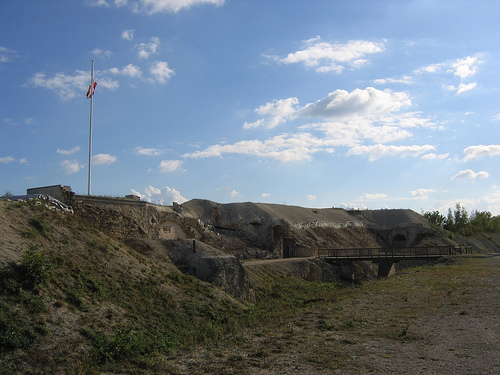

5 miles (8 km) Southeast of Reims
Tel. 03 26 49 11 85
The Fort de la Pompelle, (temporarily: Fort de Herbillon) was built between 1880 and 1883 to complete the fortifications around Reims. It was part of the fortification system that was built by General Séré de Rivières on the French eastern border after the war of 1870. It became key to the defense of Reims and a focal point during the First World War.
For a time it was named after General Émile Herbillon. By presidential decree of January 21, 1887, the Minister of War Georges Boulanger implemented that all forts, fortified artillery installations and barracks of the Système Séré de Rivières have to bear the names of former military commanders. On October 13, 1887, this was reversed by Boulanger's successor, Théophile Ferron, and the fort was given back its original name.
The area amounts to 2.31 hectares, the fort was armed with six Canon de 155 mm C modèle 1881 and four Canon de 138 modèle 1873-74. There were also five revolver cannons as flanking guns and some mitrailleuses. Three old Canon 12 de culasse modèle 1884 twelve-pounders were still part of the inventory in the moat weirs as relics. The crew consisted of an artillery company with a strength of 277 men. The complex had the base of a rectangle with a blunt recessed valley and was surrounded by a ditch with a steel lattice fence. A drawbridge crossed this valley moat. On the left shoulder there was a double trench caponier to cover the front and left flank, on the right shoulder a single caponier to cover the right flank. The Kehlgraben was secured by two Kehlgraben lines on either side of the entrance. The fort was listed as a stone construction with an approx. 2.5 m high earth cover on the roof. Due to the design, an infantry defense from here was not provided. By the end of the war, some underground passages had been dug several hundred yards through the chalk to the rear lines to allow safe access. It was built as an intermediate fort to cover the flanks of the main forts, Fort Nogent l'Abessee to the north and Fort de Montbré to the south-west.
The fort is still on the territory of the commune of Puisieulx, about five kilometers south-east of Reims on Route Départementale 944 (ex-Nationale 44), which runs from Reims to Châlons-en-Champagne. In the meantime, Reims and its suburbs have grown close to the fort.
Dearmed in 1913, the fort was captured on September 4, 1914 by
advancing German troops. Due to the retreat of the Germans after the
Battle of the Marne, the French 138th Infantry Regiment (138e régiment
d'infanterie) was able to occupy it again on September 24, 1914. It
remained permanently in French hands from then on, withstanding heavy
German artillery fire and repeated infantry attacks. In the further
course of the war, the "Pump Castle" played a formative role, because
the danger emanating from the fort for the Germans also resulted in
bombardments with serious consequences for the region and not
inconsiderable collateral damage in the city of Reims.
The
fortification was defended within the framework of the rotation system
practiced by the French army by a total of 180 different infantry
regiments as well as by two Russian units (brigades spéciales russes),
which Tsar Nicholas II had personally assigned to France in 1916. They
were supported by some French Navy gunboats, which were anchored on the
Canal de l'Aisne à la Marne between Sept-Saulx and Courmelois and
shelled the German lines from there. During the Third Battle of the
Aisne, the fort was massively attacked by German troops three times,
e.g. on June 1, 1918 with 15 armored cars. It was briefly conquered by
the 465th Infantry Regiment of the 238th Infantry Division. However, due
to the weak forces, it could not be held.[5] The fort was occupied by
units of the "1. Colonial Army Corps" ("1er Corps d'Armée Colonial")
under Général Mazillier, these units kept the fort occupied until the
armistice.
The strength of the defenders was up to 2,000 men, who
were housed in poor conditions in the partially destroyed fort.
After the end of World War I the fort was abandoned
and left to its own devices. On March 23, 1922, it was declared a
monument historique.
In 1955, the domain administration
(l'administration des Domaines) offered the site and the building for
sale. This upset the associations of former combatants (Associations
d'anciens combattants), whereupon, to smooth things over, the fort was
acquired by the "Fédération national André Maginot" and for a symbolic
franc from the city of Reims for permanent use was left. Since that
time, Reims has been the owner of the site.
Today the "Musée du Fort de la Pompelle" is located in
the accessible part of the complex. It was inaugurated on November 10,
1972 by Michel Debré, Minister of Defense at the time. The museum
exhibits, unique in the world, a collection of 560 German military
headgear, a large collection of sabers, orders and medals, as well as
uniforms.
A plaque in the museum commemorates the fallen French
fighter pilot René Dorme, who was shot down over the fort by the German
fighter pilot Heinrich Kroll in 1917.
On November 11, 1968, Jean
Taittinger, Mayor of Reims, said in a speech:
« La Ville de Reims
reconnaissante du sacrifice des milliers de ses défenseurs, a décidé que
ce sol sacré ferait désormais partie du patrimoine de la Cité. Le nom du
Fort de la Pompelle mérite d'être gravé pour l'éternité dans les annales
de la patrie! »
“The city of Reims gratefully acknowledges the
sacrifices made by thousands of its defenders here and it has been
decided that this sacred ground is a part of this city's heritage. The
name of Fort de la Pompelle deserves to be forever immortalized in the
annals of the fatherland.”